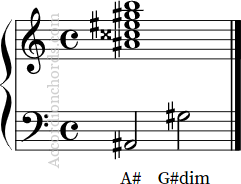AKA: A sharp 7b9, A#7 Flat 9, A#7(b9), A#7/b9, A# Dominant 7th b9, A# Dominant Seventh Flat Nine
A#7b9 Accordion Chord Chart

7b9 Chords
A dominant 7b9 chord is a chord that is composed of a root note, a major 3rd, a perfect 5th, a minor 7th, and a minor 9th. It is created by stacking a major 3rd, followed by a minor 3rd, then another minor 3rd, and finally another minor 3rd on top of the root note. This can be seen in the example of a C7b9 chord, which consists of the notes C, E, G, Bb, and Db, where C-E is a Major 3rd, and E-G, G-Bb, Bb-D are all minor 3rd intervals. This chord is often used in jazz music and can add a bluesy, dissonant sound to your performance.
7b9 Accordion Chords
On a Stradella system accordion, you can play a 7b9 chord by combining the root note with its major chord (optional) and the diminished 7th chord built on the minor 7th degree of the major scale. For example C7b9 can be played pushing the C (root) + C Maj (Major chord) + Bb dim7 buttons (diminished 7th chord built on the minor 7th degree of the Major scale).
In this case, you have to play the A# (bass note) + A# Maj chord (A#, Cx, E#) + G# dim7 chord (G#, B, F).
The Major chord and the diminished 7th chord have one note in common (E# is an F), so the Major chord only brings the third to form a 7b9 chord. Therefore, the Major chord can be omitted without affecting the sound of the chord.

Notes:
A#, Cx, E#, G#, B
(A#, D, F, G#, B)
Intervals:
R, 3°, 5°, m7°, m9°
Left hand:
A# + G#dim
(B♭ + A♭dim)
Optional:
A# + A# Major + G#dim
(B♭ + B♭ Major + A♭dim)
Fingering:
3 + 2 or 4 + 2
Optional: 4 + 3 + 2